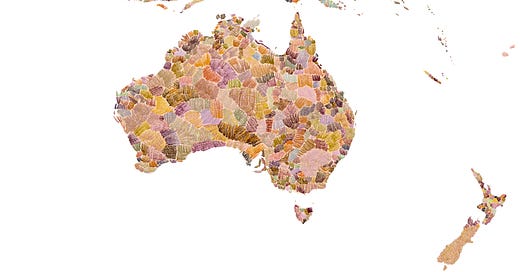There are 250 Aboriginal Nations across Australia Aboriginal Land, and each Nation is defined by its own unique territory, language and culture.
Aboriginal Nations are the oldest continuing cultures in the world with the oldest oral histories. Aboriginal oral histories can be dated back to the first arrival of humans on the Continent over 65,000 years ago. These oral histories can recall megafauna (over 45,000 years ago) and the flooding of the Continent at the end of the last ice age (12,000 years ago). Oral histories have been maintained through ingenious methods of recording and passing knowledge down the generations via ceremonial songlines.
Aboriginal languages on the Continent belong to two families, Pama Nyungan and Non Pama Nyungan. The majority of Aboriginal languages are Pama Nyungan, with a grammar structure that only uses suffixes. The Non Pama Nyungan are a small group of languages situated in the Kimberley and Arnhem Land region in the north of the Continent, with grammar structure combining prefixes and suffixes with a root word. These diverse language families include over 250 languages with over 800 distinct dialects.
Aboriginal languages have connections with languages in Asia and the pacific. Languages in the Kimberley and Arnhem Land region have been influenced by trade with Makassan seafarers from SouthEast Asia. Aboriginal people on the northern tip of Cape York have had cultural relationships with Torres Strait Islanders and Papuan people in the Pacific for thousands of years. Our map shows the Indigenous language groups of the Continent, South East Asia and the Pacific region prior to European colonisation which began in the 16th century. Since European colonisation, Indigenous languages have continued to be influenced by intercultural relationships with English, Afghan and Chinese people.
Since British invasion and colonisation of Aboriginal Land in 1788, many Aboriginal people were displaced from their lands and removed to Christian missions, where the speaking of Indigenous languages and the practice of Indigenous culture were forbidden. While 250—300 languages were spoken in 1788, only 120 languages are still actively spoken today and 90% are considered endangered. This loss of language is a direct result of colonisation.
Aboriginal Nations have their own distinct territories with geographical boundary lines, such as mountain ridges, coastlines or river ways. For example, the land upon which the colonial state of South Australia has been imposed contains the geographical territory borders of the following language groups: the Ngarrindjeri Nation on the lake system of the lower Murray River, Peramangk in the Adelaide Hills, Kaurna on the Adelaide Plains, Ngadjuri in the Barossa Valley and Narungga on the York Peninsula.
Prior to British colonisation, Aboriginal Nations were very stable, and conflict with neighbouring Nations was minor. This stability was maintained through good systems of communication. Aboriginal people spoke multiple neighbouring languages and upheld the social structures of kinship, moiety and totem systems, helping to create intercultural relationships with neighbouring families and binding them together to avoid conflict. One of these practices we continue to perform today is the Acknowledgement and Welcome to Country when travelling on someone else’s land.
Aboriginal Nations had different forms of government and custodial land ownership. In 1841, German missionary Christian Teichelmann described the Kaurna Nation as a ‘republican tribe’ maintaining a system of land ownership called ‘Pangkarra’ where land was passed from father to son. While the Kaurna ‘Pangkarra’ system is paternal, the majority of Aboriginal Nations are maternal and land ownership is passed down from mother to daughter.
When the British invaded and colonised Aboriginal Land in 1788, they claimed the land was ‘terra nullius’ (no man’s land).
REFERENCES
https://aiatsis.gov.au/explore/land-rights
https://www.nma.gov.au/defining-moments/resources/aboriginal-land-rights-act
https://www.reconciliation.org.au/wp-content/uploads/2017/11/1608-Lets-Talk_Land-Rights.pdf
https://aiatsis.gov.au/explore/living-languages
https://www.clc.org.au/articles/info/aboriginal-languages/
https://www.firstlanguages.org.au/about/about
https://www.commonground.org.au/learn/indigenous-languages-avoiding-a-silent-future
Teichelmann, C 1841 Aborigines of South Australia : illustrative and explanatory notes of the manners, customs, habits and superstitions of the natives of South Australia.
Nunn, P 2018 the Edge of Memory: Ancient Stories, Oral Tradition and the Post-Glacial World
Dixon,R 2019 Australia Original Languages



